Why Should I Bring my Pet to Willows for Treatment of Atlanto-axial Subluxation?
Willows is one of Europe’s leading small animal referral centres. Our state-of-the-art hospital is led by internationally renowned Specialists, committed to providing the highest standards of veterinary care. Our Neurology and Orthopaedic Specialists are supported by our multi-disciplinary team of Specialists across several different disciplines including; Anaesthesia, Diagnostic Imaging and Emergency and Critical Care.
Willows also has a large dedicated team of Vets, Nurses, Physiotherapists and clinical support staff available 24 hours a day, every day of the year to provide the best possible care for your pet.
What is the Atlanto-axial?
The atlanto-axial joint is the joint between the first and second cervical bones (vertebrae) in the neck (known the atlas and axis). It differs from the joints between the other vertebrae as there is no ‘disc’ present. Instead, the atlanto-axial joint is stabilised by ligaments just like those in the joints in a leg. The design of this joint allows the dog’s head to move from side to side.
What does Atlanto-axial Subluxation Mean?
Subluxation of the atlanto-axial joint occurs when the normal alignment of the first and second vertebrae in the neck is disrupted. This results in excessive movement of this joint (instability) which can cause neck pain and pressure on the nerves of the spinal cord which runs through the tunnel created by the vertebrae (vertebral canal). Although an injury can result in damage to the ligaments or the vertebrae, it is more common that dogs are born with an abnormality of the second cervical vertebra (the axis) or of the ligaments, making them more likely to develop greater subluxation, often as a consequence of minimal trauma.
What are the Most Common Causes of Atlanto-axial Subluxation?
Although any dog could develop atlanto-axial subluxation due to trauma, it is most commonly seen in toy breeds of dogs i.e. Yorkshire Terriers or Poodles. Very rarely it can occur in cats. Often in toy breeds of dogs, a congenital abnormality underlies the problem, and so the condition is most often seen in dogs less under the age of one.
What are the Signs of Atlanto-axial Subluxation?
Affected dogs may show signs of neck pain, such as yelping and crying or rigidity of the neck. More subtle signs may include a low head carriage or difficulty lowering the head to eat or drink. Signs of spinal cord injury can vary in severity, from mild weakness or lack of co-ordination in all four limbs to an inability to stand and walk.
How is Atlanto-axial Subluxation Diagnosed?
A neurological examination is necessary to detect evidence of spinal cord injury and possible neck pain. Investigations usually require a general anaesthetic and this is undertaken with extreme care, as manipulation of the neck can exacerbate any spinal cord injury.
X-rays of the neck can be very useful for diagnosing atlanto-axial subluxation, however they only provide limited information about any underlying bone deformity and no information regarding the severity of any spinal cord injury.
Sometimes more advanced imaging techniques such as an MRI or CT scan are required. A CT scan can confirm the diagnosis and provide more detailed information about any bone deformity, which in turn can help with the detailed planning required for a potential surgical procedure. MRI can also confirm the diagnosis, help in assessing any spinal cord injury, and it can rule out other brain or spinal cord abnormalities that may be present. In some situations a combination of X-rays, MRI and /or CT may be required.
How can Atlanto-axial Subluxation be Treated?
The two ways to manage atlanto-axial subluxation are:
Conservative treatment: This involves strict cage rest, application of a neck brace and giving painkillers. Maintaining a neck brace, often for several weeks, is very difficult and is poorly tolerated by many patients.
Surgery: The aim of surgery is to stabilise (fuse) the atlanto-axial joint in a normal position. This alleviates neck pain and enables the spinal cord to recover from injury. A number of surgical techniques can be used, the most reliable approach involves placing bone screws into the first and second cervical vertebrae (the atlas and axis) and connecting the screws together with special bone cement. The surgery is performed through an incision made on the underside of the neck. It is a very intricate procedure due to the location of the problem and the small size of many of these patients. Atlanto-axial subluxation surgery should only be performed by experienced surgeons with advanced training.
What Can I Expect if my Pet is Treated for Atlanto-axial Subluxation?
The outlook with atlanto-axial subluxation depends on how it is managed.
With conservative treatment, although an improvement can be expected in many patients, pain and spinal cord injury often recur once the neck brace is removed and activity is increased. As a consequence, surgical stabilisation of the atlanto-axial joint is indicated in most patients.
The success rate with surgery is generally good provided the atlanto-axial joint is adequately realigned and screws and cement are placed in the bones in a safe manner. The prognosis tends to be better in dogs that show clinical signs whilst still young, can still walk prior to surgery and where signs have not been present for a long time.
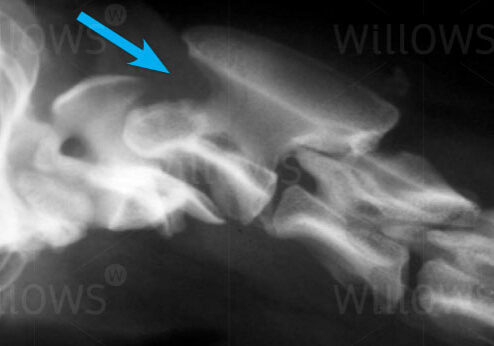
X-ray of the neck in a miniature breed dog showing separation of the first two bones in the neck, leading to an increased space between them (arrowed)
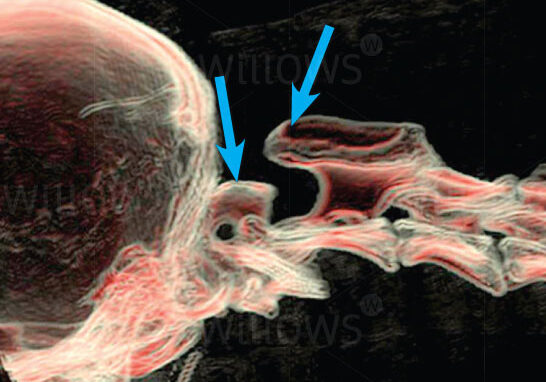
CT scan showing two vertebrae in the neck partially separated before surgery (arrows)
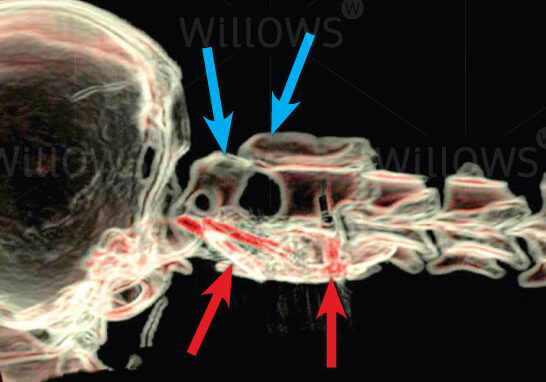
CT scan after the operation showing the two vertebrae back together again (blue arrows) The screws are visible and show as red on this image (indicated by red arrows) and they are supported by a plug of cement under the bones
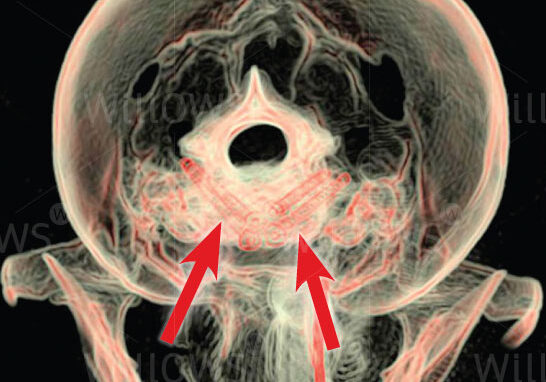
A CT scan looking from behind the skull, showing the screws in the bones from a different angle (indicated by arrows)
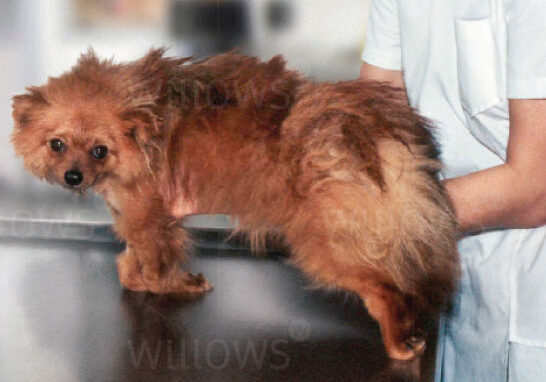
A young Chihuahua before surgery for atlanto-axial subluxation

A young Chihuahua after surgery for atlanto-axial subluxation. Stabilising the bones at the top of the neck abolished pain and enabled this small dog to walk again.
To save this page as a PDF, click the button and make sure “Save as PDF” is selected.
Neurology
Find out more
To assist owners in understanding more about Neurological conditions, investigations and treatment we have put together a range of information sheets to talk you through the some of the more common neurological conditions seen by our Specialists.

